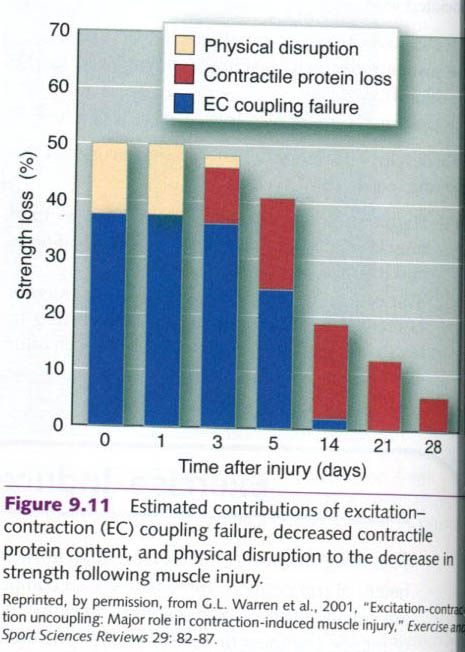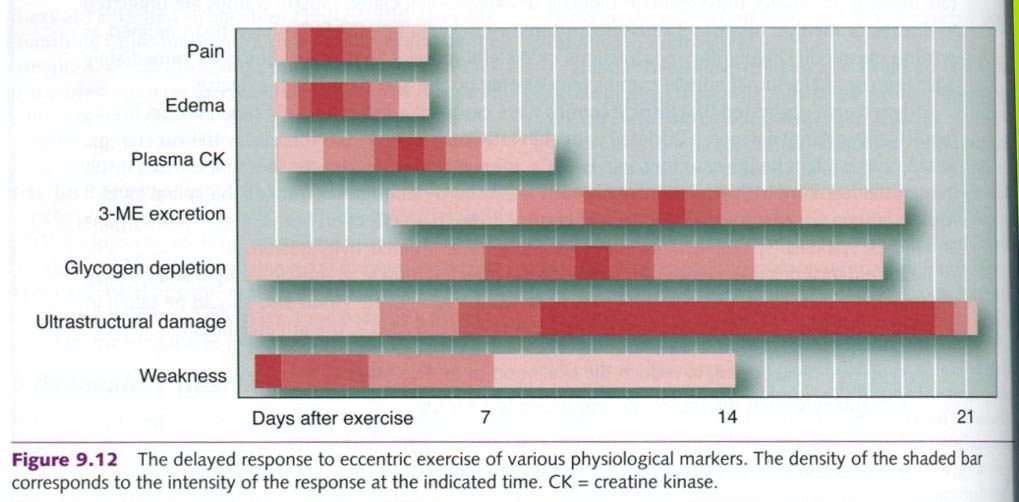Acute muscle soreness
Pain felt during and immediately after exercise
can result from accumulation of the end products of exercise, such as H+,
and from tissue edema, mentioned earlier, which is caused by fluid shifting
from the blood plasma into the tissues. Edema is the cause of the pumped-up
sensation that people feel after heavy endurance or strength training. The pain
and soreness usually disappear within a few minutes to several hours after the
exercise. Thus, this soreness is often referred to as acute muscle soreness.
Delayed-onset muscle soreness and injury
Muscle soreness felt a day or two after a heavy
bout of exercise is not totally understood, yet researchers are continuing to
give us greater insight into this phenomenon. Because the pain does not occur
immediately, it is reffered to as delayed-onset
muscle soreness(DOMS).
Here will be discussed theories that attempt to explain this form of muscle
soreness.
Almost all current theories acknowledge that
eccentric action is the primary initiator of DOMS. This was clearly
demonstrated in a study of the relationship of muscle soreness to eccentric,
concentric, and static actions. This study showed that a group who trained
solely with eccentric actions experienced extreme muscle soreness, whereas the
static- and concentric- action groups experienced little soreness. This idea
was further explored in studies in which subjects ran on a treadmill for 45 min
on two separate days, one day on a level grade and the other day on a 10%
downhill grade.
No muscle soreness was associated with the
level running. But the downhill running, which required extensive eccentric action,
resulted in considerable soreness within 24 to 48h, even though blood lactate
levels, previously thought to cause muscle soreness, were much higher with
level running.
Structural
damage
The presence of increased concentrations of
several specific muscle enzymes in blood after intense exercise suggests that
some structural damage may occur in the muscle membranes. These enzyme levels
increase from 2 to 10 times their normal levels following bouts of heavy
training. Recent studies support the idea that these changes might indicate
various degrees of muscle tissue breakdown. Examination of tissue from the leg
muscles of marathon runners has revealed remarkable damage to the muscle fibers
after both training and marathon competition. The onset and timing of these
muscle changes parallel the degree of muscle soreness experienced by the
runners.
Although the effects of muscle damage on
performance are not fully understood, experts generally agree that this damage
is responsible in part for the localized muscle pain, tenderness, and swelling
associated with DOMS. However, blood enzyme levels might increase and muscle
fibers might be damaged frequently during daily exercise that produces no
muscle soreness. Also, remember that muscle damage appears to be a precipitating
factor for muscle hypertrophy.
Inflammatory
reaction
White blood cells serve as a defense against
foreign materials that enter the body and against conditions that threated the
normal function of tissues. The white blood cell count tends to increase
following activities that induce muscle soreness. This observation led some
investigators to suggest that soreness results from inflammatory reactions in
the muscle. But the link between these reactions and muscle soreness has been
difficult to establish.
Researchers have tried to use drugs to block
the inflammatory reaction, but these efforts have been unsuccessful in reducing
the amount of muscle soreness or the degree of inflammation. Because both
effects remain, conclusions about the role of inflammation in muscle soreness
cannot be drawn from this research. More recent studies, however, are beginning
to establish a link between muscle soreness and inflammation. For example, it
is now recognized that substances released from injured muscle can act as
attractants, initiating the inflammatory process. Mononucleated cells in muscle
are activated by the injury, providing the chemical signal to circulating
inflammatory cells. Neutrophils(a type of white blood cell) invade the injury
site and release cytokines(immunoregulatory substances), which then attract and
activate additional inflammatory cells. Neutrophils possibly also release
oxygen free radicals that can damage cell membranes. Macrophages(another type
of cell of the immune system) then invade the damaged muscle fibers, removing
debris through a process known as phagocytosis. Last, a second phase of
macrophage invasion occurs, which is associated with muscle regeneration.
Sequence
of events in DOMS
In 1984, Armstrong reviewed possible mechanisms
for exercise-induced DOMS. He concluded that DOMS is associated with:
- Elevations in plasma
enzymes,
- Myoglobinemia(presence of
myoglobin in the blood), and
- Abnormal muscle histology
and ultrastructure.
He developed a model of DOMS that proposed the
following sequence of events:
1.
High tension in the contractile-elastic system
of muscle results in structural damage to the muscle and its cell membrane.
2.
The cell membrane damage disturbs calcium homeostasis in the injured
fiber, resulting in necrosis(cell death) that peaks about 48h after exercise.
3.
The products of macrophage activity and
intracellular contents(such as histamine, kinins, and K+) accumulate outside the cells. These substances then
stimulate the free nerve endings in the muscle. This process appears to be
accentuated in eccentric exercise, in which large forces are distributed over
relatively small cross-sectional areas of the muscle.
Recent comprehensive reviews have provided much
greater insight into the cause of muscle soreness. We now are confident that
muscle soreness results from injury or damage to the muscle itself, generally
the muscle fiber and possibly the plasmalemma. This damage sets up a chain
of events that includes the release of intracellular proteins and an increase
in muscle protein turnover. The damage and repair process involves calcium ions, lysosomes, connective
tissue, free radicals, energy sources, inflammatory reactions, and
intracellular and myofibrillar proteins. But the precise cause of skeletal
muscle damage and the mechanisms of repair are not well understood. Some
evidence suggests that this process is an important step in muscle hypertrophy.
Up to this point, our discussion of DOMS has
focused on muscle injury. Edema, or the accumulation of fluids in the muscular
compartment, also can lead to DOMS. This edema is likely the result of muscle
injury but could occur independently of muscle injury. An accumulation or
interstitial or intracellular fluid increases the tissue fluid pressure within
the muscle compartment, which in turn activates pain receptors within the
muscle.
Delayed-onset muscle soreness and performance
With DOMS comes a reduction in the
force-generating capacity of the affected muscles. Whether the DOMS is the
result of injury to the muscle or edema independent of muscle injury, the
affected muscles are not able to exert as much force when the person is asked
to apply maximal force, such as in the performance of a 1RM strength test.
Maximal force-generating capacity gradually returns over days or weeks. It
has been proposed that the loss in strength is the result of three factors:
- The physical disruption of
the muscle ,
- Failure within the
excitation – contraction coupling process,
- Loss of contractile protein.
Failure in excitation – contraction coupling
appears to be the most important, particularly during the first five days.
Muscle glycogen resynthesis also is
impaired when a muscle is damaged. Resynthesis is generally normal for the
first 6 to 12h after exercise, but it slows or stops completely as the muscle
undergoes repair, thus limiting the fuel-storage capacity of the injured
muscle. Figure below illustrates the time sequence of the various factors
associated with intense eccentric exercise, including pain, edema, plasma
creatine kinase( a plasma enzyme marker of muscle fiber damage), glycogen depletion, ultrastructural
damage in the muscle, and muscular weakness.
Reducing the negative effects of DOMS
Reducing the negative effects of DOMS is
important for maximizing training gains. The eccentric component of muscle
action could be minimized during early training, but this is not possible for
athletes in most sports. An alternative approach is to start training at a very
low intensity and progress slowly through the first few weeks. Yet another
approach is to initiate the training program with a high-intensity, exhaustive
training bout. Muscle soreness would be great for the first few days, but
evidence suggests that subsequent training bouts would cause considerably less
muscle soreness. Because the factors associated with DOMS are also potentially
important in stimulating muscle hypertrophy, DOMS is most likely necessary to maximize the training
response.











2 коментара:
Really amazing article at all! And I got some good information from this article. Really I was looking forward to read about it. Thanks for this allocation. back muscle pain in HongKong
It's a really informative post, keep up the good work. Also try our IASTM Tools for Sore Muscles that helps to heal your sore muscles, hand and wrist strain, heal soft tissue damage and share your experience.
Постави коментар